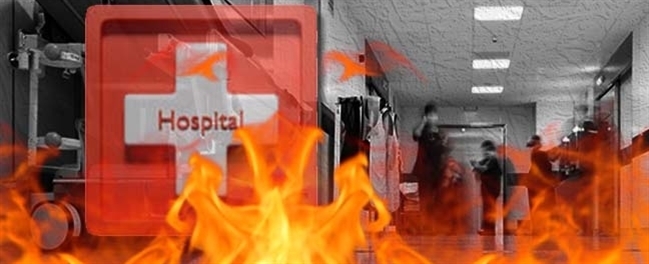
Fire incidents always result in pecuniary and non-pecuniary losses in a large part of the society. Similar results and similar emotions are experienced during the fires occurring largely in our country. But, they are forgotten soon.
The incident of fire that occurred on 26 May 2009 at Bursa Şevket Yılmaz Hospital caused the death of 8 people and material losses at the hospital. In the examination made after the fire, it was observed that the fire was not of very large size. However, many factors such as insufficient security measures taken in the building, regulations not implemented, employees not trained on fire, etc. showed how a painful event occurred.
With this study, it is aimed to show how an actual fire incident reminds us of what to pay attention to and that the fire is a very serious event once more.
Hospitals are the buildings where inpatients and outpatients are treated and where there is a high density of people such as visitors and employees. The organizations and administrations of hospitals vary according to various countries. The number of people in need of help is high, and there is a high probability of any kind of danger occurring in these buildings at any time. Fires are also an important hazard.
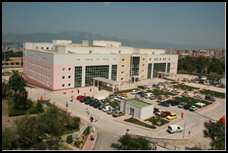
Photo 1
When the risk analyses of hospitals are made, it is seen that fire risk is an important problem for all hospitals. Hospitals have a potential for fire breakout at any time due to their infrastructure features. There are many potential hazards in hospitals such as kitchens, lofts, transformers, electrical installations, flammable-explosive materials, oxygen systems, nitrogen systems, cigarettes. Taking the necessary precautions against all these hazards, activating early alarm and intervention systems, raising awareness of all personnel and knowing what to do in case of possible situations will prevent a disaster that may arise.
The factor that constitutes the loss of life in hospitals during fires is the wrong actions taken to evacuate the building in a short time. For this, emergency plans of hospitals should be developed in advance.
I conducted a crime scene investigation with my teammates who experienced a fire incident in Bursa province that revealed this situation, and in light of the information obtained, the consequences of a hospital fire will be shared.
Şevket Yılmaz State Hospital in the central Yıldırım district of Bursa city is a reinforced concrete building with -2 floors and 6 floors above the entrance (in the photo 1). In the Tomography Service located on the A-2 ground floor of the building, a fire broke out from the electrical contact at the electric cable entry of the computer housing, which was found next to the secretary's desk at 02.00 am on 26 May 26 2009. Due to the high number of flammable items in this section, flames surrounded this floor in a short time. Hospital personnel tried to get the patients out in panic.
The condition of the area where the fire occurred is shown in photos 2 and 3.
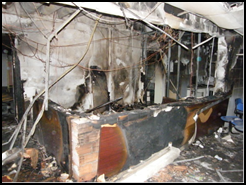
Photo 2
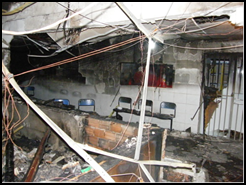
Photo 3
As you can see from the photos, this is the damage caused by the fire. This area is located at -2 floor of the ground floor and is used as a radiology unit. The intensive care unit, which resulted in the grievous consequence, is located on the 3rd floor above the entrance.
In the examination, there is an electric shaft channel extending to the top floor (roof) on the ceiling directly above the fire area (in the photo 4). This channel carried the hot gases and flame of the fire on the -2 floor upwards with stack effect. Insulation of electric cables in vertical position in the shaft channel was burned. Since the electric shaft covers between the floors were wooden, they were easily burned, causing smoke to spread to the other floors (in the photo 5).
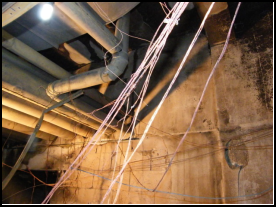
Photo 4
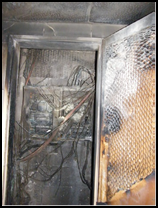
Photo 5
This electric shaft channel extends to the roof by passing through the intensive care unit located on the 3rd floor of the building. Since this was the 3rd floor, the hot gases coming from the lower floors accumulated and burned the electric shaft cover (in the photo 6). A stretcher was standing in front of the cover and this stretcher was completely burned by the heat coming from inside the shaft channel (in the photo 7). The gases that occurred as a result of this combustion covered the intensive care unit and caused the patients to be stuck in a difficult situation. Eight of the patients died here.
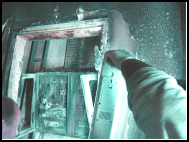
Photo 6
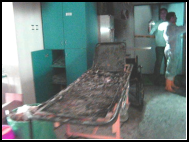
Photo 7
After the fire incident, certain witness statements and technical examinations were used. In addition to finding the cause of the fire outbreak, this incident has been used to minimize the fire risks in hospitals and suggestions have been prepared.
-This fire incident first showed that the personnel in the hospital were not adequately trained in the techniques of responding to and rescuing a point-based fire. This is summarized in a witness statement.
“I responded to 3 patients; they were intensive care patients... But I lost one of them. The patient was removed from intensive care support without any plan or program.There was an unorganized rescue operation. While the patients whose condition was not severe during the fire were taken to the garden, there was a complete disaster in the Intensive Care Service where there were 16 patients on the 3rd floor of the hospital. During the panic that occurred during the fire, patients lost their lives due to the power cut, unplugging, and being heavily affected by smoke. The other 8 patients in this department were delivered to other hospitals”.
Certain results obtained from the examination conducted by the Technical Committee of Bursa Provincial Coordination Board of TMMOB (also published in the press);
This fire incident with grievous result,
-First of all, showed that the building should be used in accordance with the construction, that is, there should be no sections that will cause danger with additions according to the continuous need;
-The fire can occur in any environment, but it has been clearly demonstrated once more in this fire incident that the installation and operation of the communication installation will be an element that can prevent loss of life;
- The loss of life in this fire has proved once more that the requirements of the regulations will not be underestimated;
-And of course, the importance of periodical personnel training in hospitals by performing practical rescues and interventions, not simply by displaying a few videos has been understood;
The investment expenses to be allocated for the elimination of deficiencies by conducting fire risk analysis not only in hospitals but also in all buildings is not more valuable than a life that has been lost.
Our Complete Building Solutions for Hospitals and Health Institutions »